Fidschi-Tonga, 2018 – FS Sonne – Ausfahrt SO263
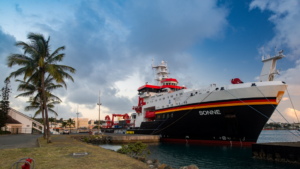
The island of Tonga in the southwest Pacific is located in one of the most geologically active regions on Earth, where over a length of about 3500 kilometers the Pacific lithospheric plate subducts below the Australian plate at a rate of about 9 cm/year and can be traced to depths of 600 kilometers by means of earthquakes.
This so-called subduction causes the upper Australian Plate to be stretched and ruptured, resulting in widespread volcanism. Thus, the majority of the islands of Tonga are volcanic in origin, but much more volcanic activity occurs beneath the ocean surface. Active volcanism in this region is accompanied by the circulation of hot solutions and massive degassing processes of sulfur dioxide and carbon dioxide.
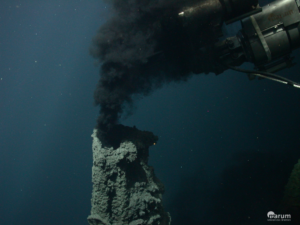
Lead by the Chair of Endogenous Geodynamics of the GeoCenter Northern Bavaria of FAU, the research vessel SONNE will investigate the volcanic processes and the input of gases and metals into the hot solutions and the ocean.
The different areas in the Australian Plate above the submerged Pacific Plate show different volcanic structures, which are apparently also fed by different melts from depths of about 100 kilometers. In the BMBF-funded project, the researchers want to investigate the formation of these melts in order to draw conclusions about the melting processes in the Earth’s mantle and the development of the Earth’s crust at such subduction zones.
In cooperation with colleagues from the Universities of Bremen and Münster, the Jacobs University Bremen, the Max Planck Institute for Marine Microbiology, the GEOMAR Helmholtz Institute for Ocean Research as well as scientists from the University of Victoria, Canada, and the University of Hawaii, USA, the hot solutions and their precipitates as well as the faunas of the solutions’ exit points will also be studied. This will provide clues about the interaction between melts of the Earth’s interior and ocean waters, the formation of ore deposits, and biological and microbiological activity based on the different hot solutions. With the help of the QUEST 4000 diving robot from MARUM at the University of Bremen, scientists can make observations and take samples down to depths of 4,000 meters.
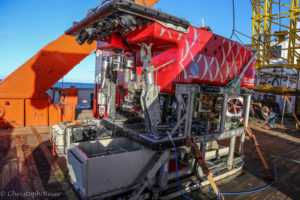
The ROV (remotely operated vehicle), an unmanned robot remotely controlled from onboard, can be used to take high-resolution images and videos of the seafloor. In addition, various tools allow rock samples to be broken off, grabbed and placed in individual recovery vessels. Biological samples, water and gas samples can be taken.
TV-Grab
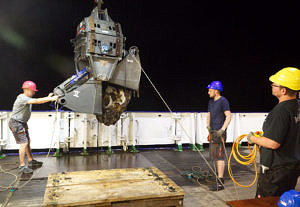
Foto: Stefan Krumm, LEG
The TV-grab is a hydraulic dredging bucket with an integrated video camera. The TVG is lowered overboard by a winch and stopped a few meters above the seafloor. Using the bow thrusters, the vessel is slowly driven in any direction until a site suitable for sampling is found. Then the TVG grabs hold and the samples are brought on board.
Crane water sampler, CTD
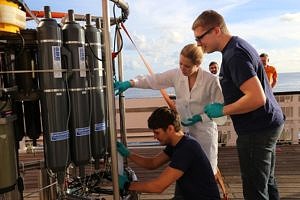
Foto: Marie Heidenreich
With the CTD, conductivity and water temperature can be determined as a function of water depth. The depth sampler allows water samples to be taken from the corresponding depths, which can then be analyzed on board or in the laboratory for other chemical, isotopic and biological parameters.
Anderson, M.O., Norris-Julseth, C., Rubin, K.H., Haase, K.M., Hannington, M.D. Baxter, A.T., and Stewart, M., 2021. Geologic and Structural Evolution of the NE Lau Basin, Tonga: Morphotectonic Analysis and Classification of Structures using Shallow Seismicity. Frontiers in Earth Science 9, 665185, doi: 10.3389/feart.2021.665185.
Falkenberg, J.J., Keith, M., Haase, K.M., Bach, W., Klemd, R., Strauss, H., Yeo, I.A., Rubin, K.H., and Anderson, M.O., 2021. Effect of fluid boiling on volatile element and Au enrichment in submarine hydrothermal sulphides, Niua South, Tonga arc. Geochimica et Cosmochimica Acta 307, 105-132. doi:10.1016/j.gca.2021.05.047.
Peters, C., Strauss, H., Haase, K., Bach, W., de Ronde, C., Kleint, C., Stucker, V., and Hesseler, V., 2021. Hydrothermal sulfur cycling: insights from multiple sulfur isotopes for hydrothermal fluids from the Tonga-Kermadec intraoceanic arc and the NE Lau Basin. Chemical Geology 586, 120586, doi:10.1016/j.chemgeo.2021.120586.
Klose, L., Keith, M., Hafermaas, D., Kleint, C., Bach, W., Diehl, A., Wilckens, F., Peters, C., Strauss, H., Klemd, R., Haase, K., and Koschinsky, A., 2021. Trace element and isotope systematics in vent fluids and sulphides from Maka volcano, North Eastern Lau Spreading Centre: Insights into three-component fluid mixing. Frontiers in Earth Science 9, 776925, doi: 10.3389/feart.2021.776925.
Haase, K.M., Schoenhofen, M.V., Storch, B., Beier, C., Regelous, M., Rubin, K., and Brandl, P.A., 2022. Effects of the hydrous domain in the mantle wedge on magma formation and mixing at the Northeast Lau Spreading Centre, SW Pacific. Geochemistry, Geophysics, Geosystems 23, e2021GC010066, doi: 10.1029/2021GC010066.
Falkenberg, J., Keith, M., Haase, K.M., Sporer, C., Bach, W., Klemd, R., Strauss, H., Peters, C., Rubin, K.H., and Anderson, M.O., 2022. Spatial variations in magmatic volatile influx and fluid boiling in the submarine hydrothermal systems of Niuatahi caldera, Tonga rear-arc. Geochemistry, Geophysics, Geosystems 23, e2021GC010259, doi: 10.1029/2021GC010259.
Storch, B., Regelous, M., Noebel, K.M., Haase, K.M., and Bauer, J., 2022. Extreme geochemical heterogeneity beneath the North Tonga Arc: interaction of a subduction zone with intraplate seamount chains. Chemical Geology 603, 120903, doi: 10.1016/j.chemgeo.2022.120903.

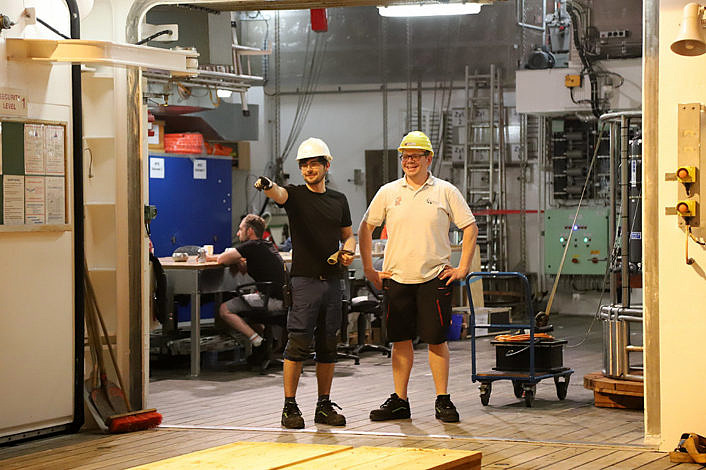 Der Probennahme geht eine detaillierte Planung voraus. Klare Anweisungen sind wichtig!
Der Probennahme geht eine detaillierte Planung voraus. Klare Anweisungen sind wichtig!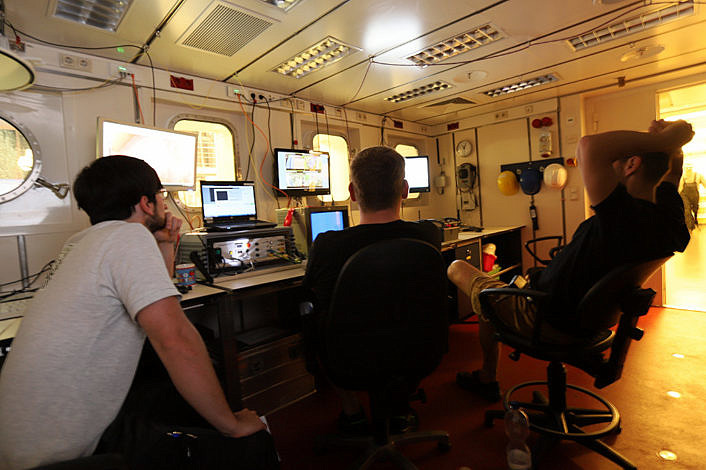 Die Greifer-Einsatzzentrale mit Kartenrechnern, Videobildschirmen und Windenkontrolle.
Die Greifer-Einsatzzentrale mit Kartenrechnern, Videobildschirmen und Windenkontrolle.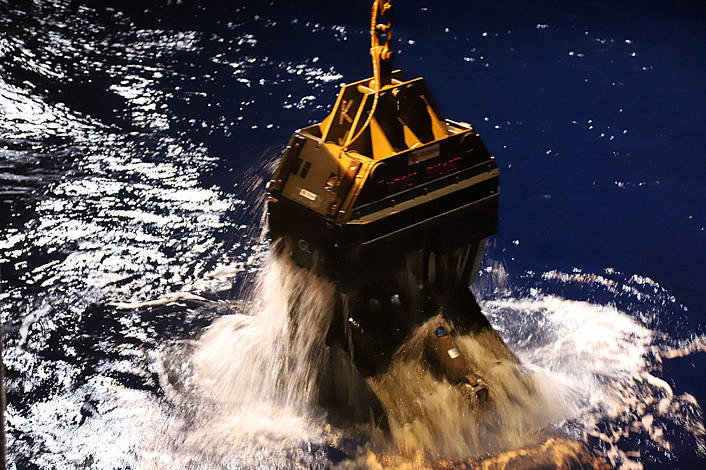 Der Greifer kommt aus dem Wasser
Der Greifer kommt aus dem Wasser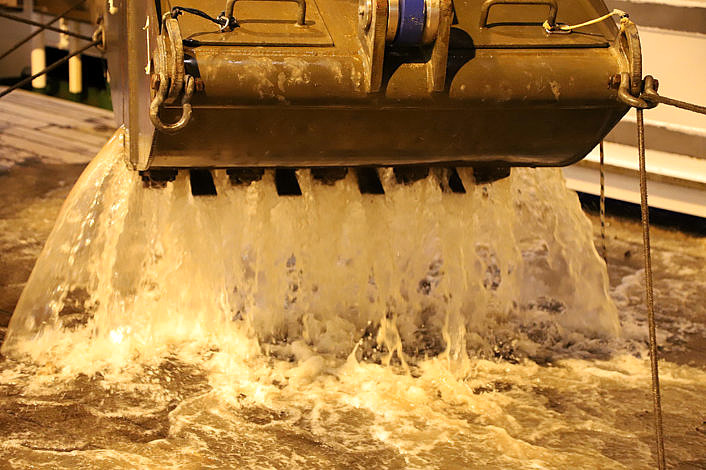 Erstmal Wasser ablassen …
Erstmal Wasser ablassen …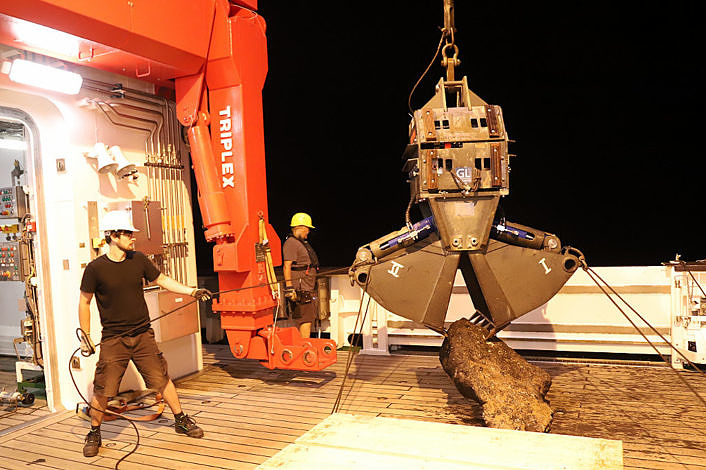 Manchmal kommt eine Überraschung an Bord. In der Kamera hatte man nur den obersten kleinen Teil des Brockens gesehen.
Manchmal kommt eine Überraschung an Bord. In der Kamera hatte man nur den obersten kleinen Teil des Brockens gesehen.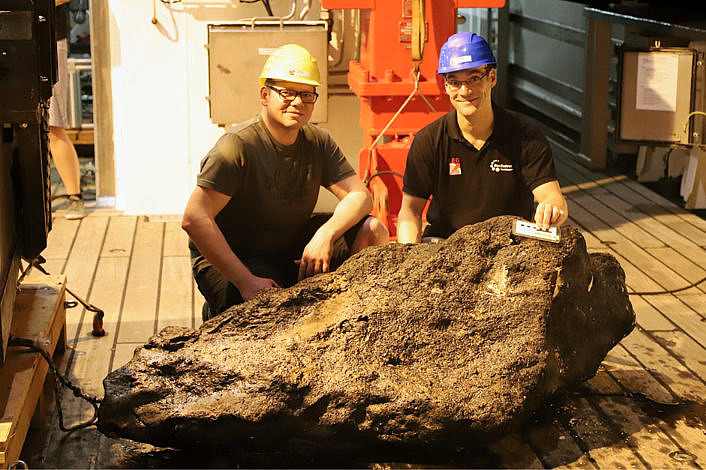 Stolze Trophäensammler. Leider musste alles ausser einem kleinen Stück wieder über Bord. Also, halt von dem Gesteinsbrocken …
Stolze Trophäensammler. Leider musste alles ausser einem kleinen Stück wieder über Bord. Also, halt von dem Gesteinsbrocken …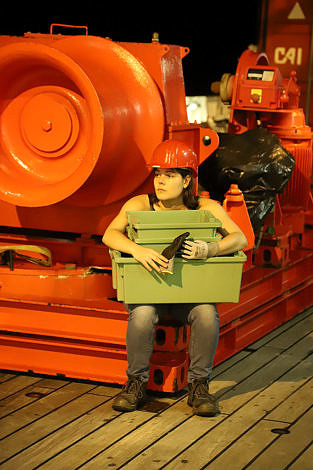 Warten auf die Probennahme.
Warten auf die Probennahme.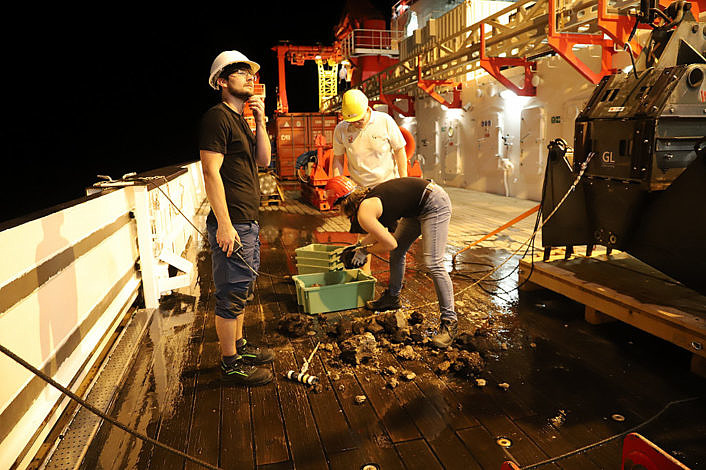 Was machen wir nur mit all den Proben, scheint Thomas G. zu grübeln.
Was machen wir nur mit all den Proben, scheint Thomas G. zu grübeln.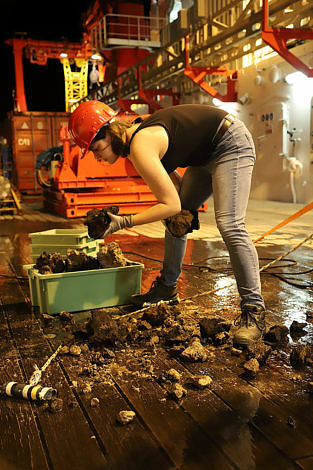 Die Kleinen in die Kiste …
Die Kleinen in die Kiste … Die großen Proben auf die Palette.
Die großen Proben auf die Palette.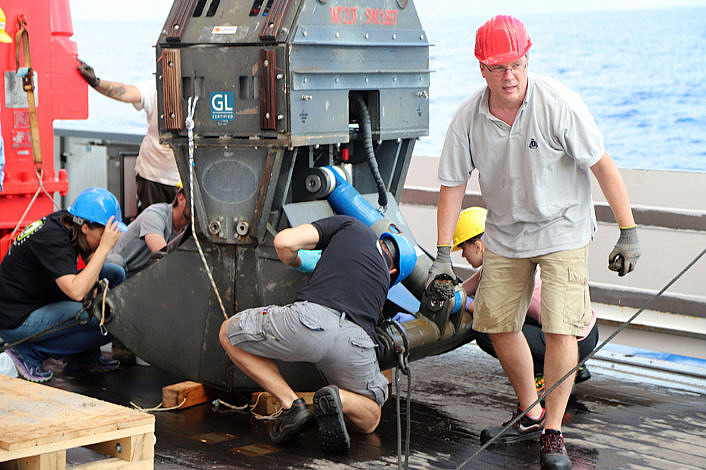 Ganz besondere Proben motivieren eine Vielzahl von Experten zur zeitgleichen Probennahme unter strenger Aufsicht des Fahrtleiters.
Ganz besondere Proben motivieren eine Vielzahl von Experten zur zeitgleichen Probennahme unter strenger Aufsicht des Fahrtleiters.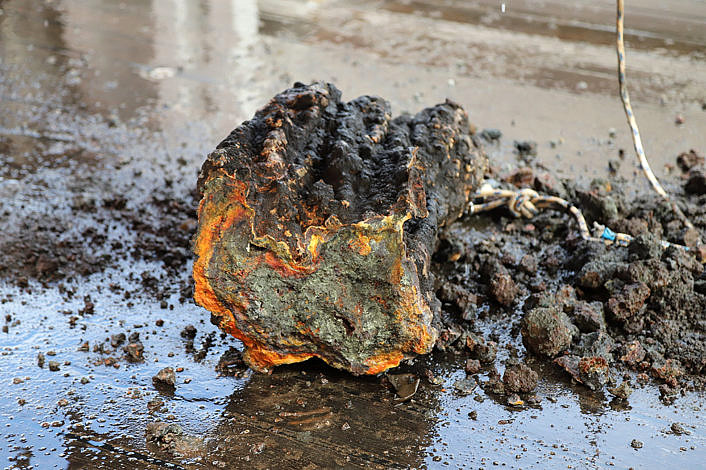 Glücksgriff: Teil eines Schornsteines eines hydrothermalen Systems mit Sulfiderzen.
Glücksgriff: Teil eines Schornsteines eines hydrothermalen Systems mit Sulfiderzen.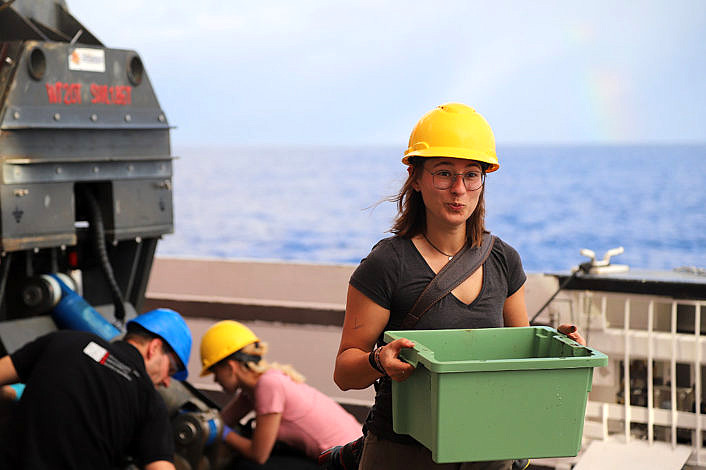 Schnell in Sicherheit bringen …
Schnell in Sicherheit bringen …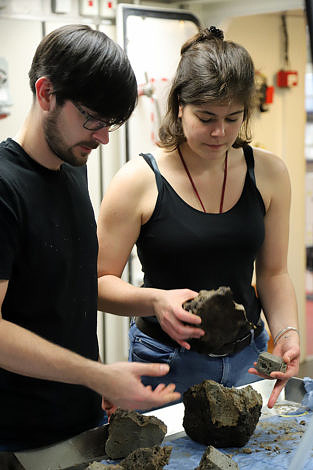 Alle Proben werden vermessen, fotografiert, beschrieben und katalogisiert.
Alle Proben werden vermessen, fotografiert, beschrieben und katalogisiert.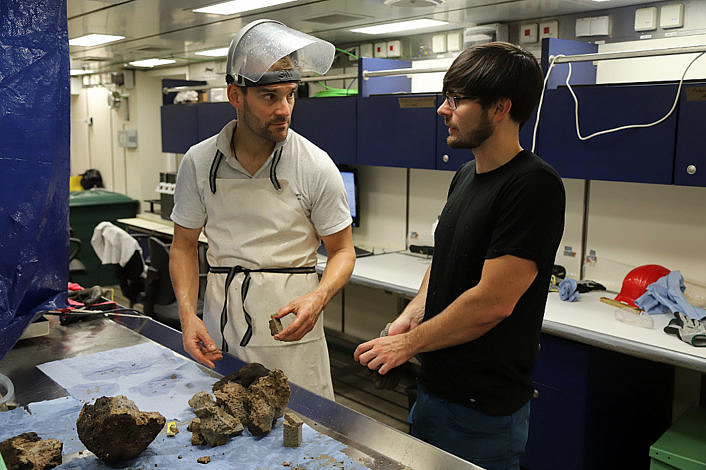 Spezielle Schutzkleidung hilft auch bei hitzigen Diskussionen.
Spezielle Schutzkleidung hilft auch bei hitzigen Diskussionen.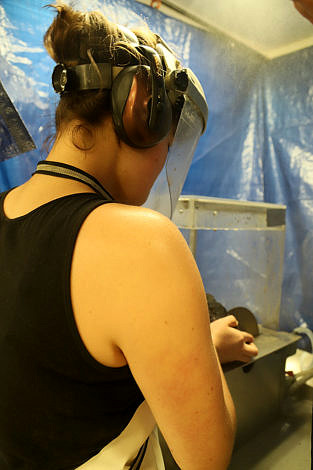 Die Gesteine werden in kleine Stücke für geochemische Untersuchungen, Dünschliffe und Belegstücke gesägt.
Die Gesteine werden in kleine Stücke für geochemische Untersuchungen, Dünschliffe und Belegstücke gesägt.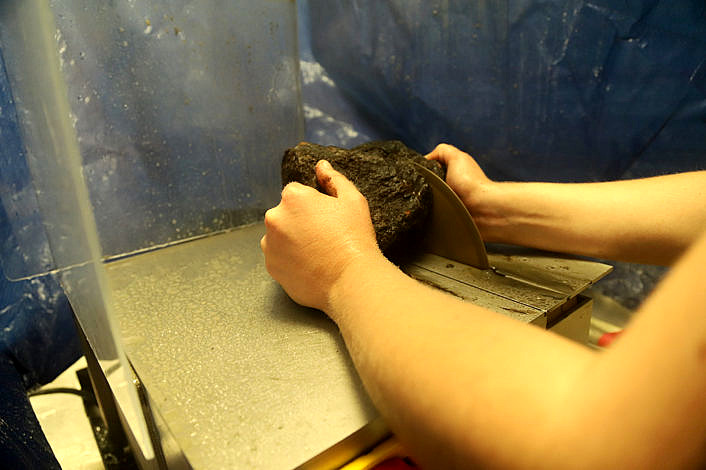 Passt gerade so eben …
Passt gerade so eben …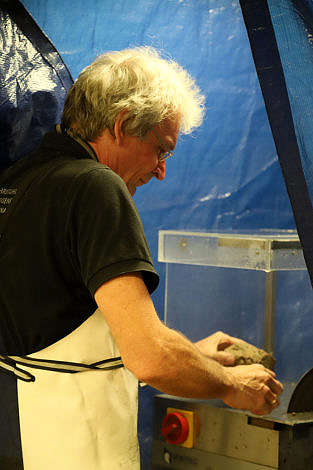 Sägen verursacht graue Haare und manchmal auch graue Bärte (Insider).
Sägen verursacht graue Haare und manchmal auch graue Bärte (Insider).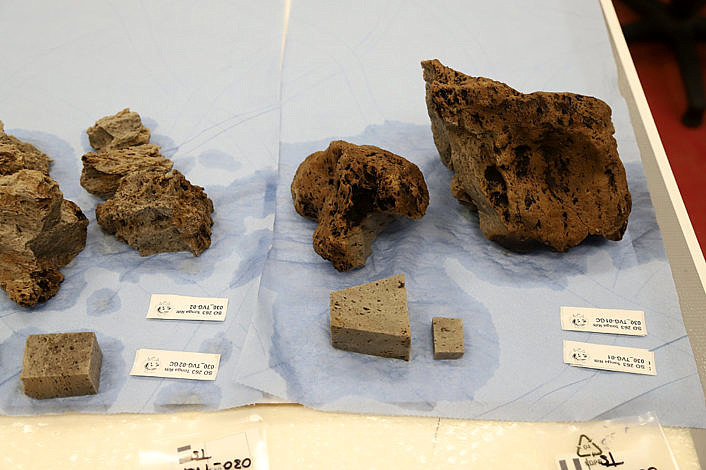 Dokumentation ist alles.
Dokumentation ist alles.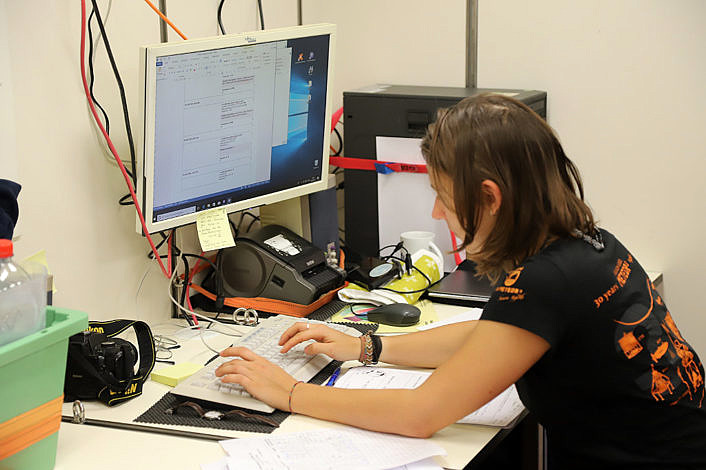 siehe zuvor …
siehe zuvor …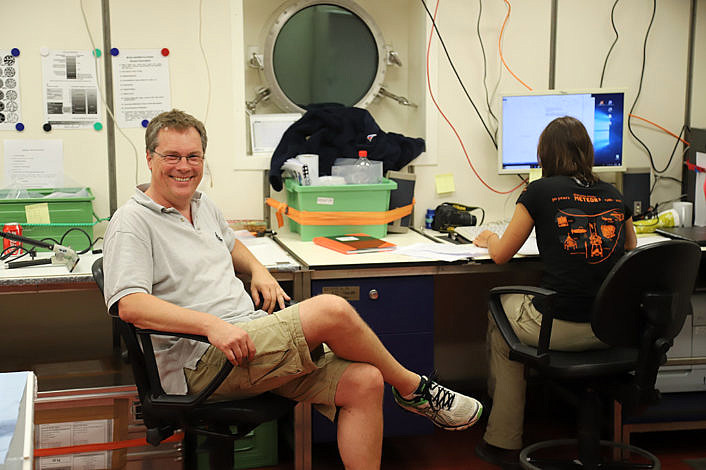 Fleissiges Team und viele gute Proben: zufriedener Fahrtleiter!
Fleissiges Team und viele gute Proben: zufriedener Fahrtleiter!